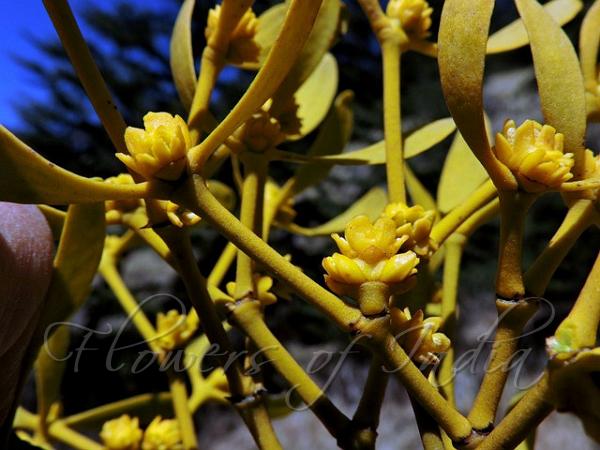|
| Common Mistletoe |
|

|

| File size | 112369 |
| Original date | 2/26/17 11:57 AM |
| Resolution | 640 x 480 |
| Flash | Flash did not fire, auto |
| Focal length | 5.9mm |
| Exposure time | 1/1250s |
| Aperture | 4.5 |
| Focus Distance | |
| Metering Mode | Multi-segment |
| Camera make | NIKON |
| Camera model | COOLPIX P530 |
| Sensor type |
|
|
|
|
Photo: |
Botanical name: Viscum album Family: Santalaceae (Sandalwood family)
Synonyms: Viscum album var. album
Synonyms: Viscum album var. album
Common Mistletoe is a hemi-parasitic shrub, which
grows on the stems of other trees. It has stems 30-100 cm long with
dichotomous branching. The leaves are in opposite pairs, strap-shaped,
entire, leathery textured, 2-8 cm long, 0.8-2.5 cm broad and are a
yellowish-green in colour. This species is dioecious and the
insect-pollinated flowers are inconspicuous, yellowish-green, 2-3 mm
diameter. The fruit is a white or yellow berry containing one (very
rarely several) seed embedded in the very sticky, glutinous fruit pulp.
It is commonly found in the crowns of broad-leaved trees, particularly
apple, lime (linden), hawthorn and poplar. Common mistletoe has always
attracted popular interest and has been surrounded by a number of myths
and legends. In cultures across pre-Christian Europe, mistletoe was
seen as a representation of divine male essence (and thus romance,
fertility and vitality). It still plays a role in the folklore of some
countries. It is native to Europe and western and southern Asia.
It is found in the Himalayas, from Afghanistan to C Nepal, at altitudes of
1000-2700 m. It is common on walnut trees in Kashmir.
Medicinal uses: The dried herb is used
consisting of younger branches with leaves, flowers and separated
fruits. It has widespread medicinal uses.
The dried herb is used
consisting of younger branches with leaves, flowers and separated
fruits. It has widespread medicinal uses.
Medicinal uses:
 The dried herb is used
consisting of younger branches with leaves, flowers and separated
fruits. It has widespread medicinal uses.
The dried herb is used
consisting of younger branches with leaves, flowers and separated
fruits. It has widespread medicinal uses. | Identification credit: Anil Thakur | Photographed in Shimla, Himachal Pradesh & Kashmir. |
• Is this flower misidentified? If yes,